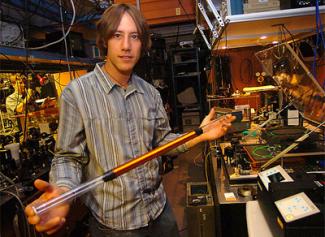With every breath you take, you breathe out carbon dioxide and roughly 1000 other different molecules. Some of these can signal the early onset of such diseases as asthma, cystic fibrosis, or cancer. Thanks to graduate student Mike Thorpe and his colleagues in Fellow Jun Ye’s group, medical practitioners may one day be able to identify these disease markers with a low-cost, noninvasive breath test. The new laser-based breath test is an offshoot of Thorpe’s research on cavity-enhanced direct optical frequency comb spectroscopy, a molecular fingerprinting technique reported in Science two years ago (See JILA Light & Matter, Spring 2006).
Optical comb spectroscopy is powerful enough to sort through all the molecules in human breath and sensitive enough to find traces of chemicals that mark the onset of disease. For example, excess methylamine might indicate liver or kidney disease; ammonia on the breathe could signal the early stages of kidney failure; traces of acetone would suggest the onset of diabetes; and higher-than-normal nitric oxide levels in combination with carbonyl sulfide, carbon monoxide, and hydrogen peroxide would point straight to asthma. The new breath test would even make it impossible for smokers to hide their unhealthy habit from their doctors.
Thorpe and his fellow researchers tested their new technique by having student volunteers breathe into an optical cavity, which is a space between two standing mirrors. The cavity was designed to bounce pulsed laser light back and forth enough times to travel several kilometers before the light exited the cavity. This design allowed the laser light to not only strike every molecule introduced into the cavity by the students, but also to create sufficient light-matter interaction time to be exquisitely sensitive to trace amounts of different substances.
The researchers compared the laser light coming out of the cavity with the light that went in. This comparison allowed them to determine the exact frequencies of light that were absorbed and by how much. This was enough information for them to rapidly identify the molecules originally present in each breath and their relative concentrations. For instance, they found carbon monoxide levels in the breath of one volunteer who was a smoker to be five times higher than in the breaths of the other nonsmoking volunteers.
The ability of Thorpe’s new breath test to detect and measure multiple biomarkers quickly and reliably is garnering worldwide interest in the new technique. If it performs as well in future clinical trials as it does in the laboratory, optical comb spectroscopy is likely to change the field of medical breath analysis. In the process, it should offer a simple, affordable, and robust method for health screening. - Julie Phillips



 The Physics Frontiers Centers (PFC) program supports university-based centers and institutes where the collective efforts of a larger group of individuals can enable transformational advances in the most promising research areas. The program is designed to foster major breakthroughs at the intellectual frontiers of physics by providing needed resources such as combinations of talents, skills, disciplines, and/or specialized infrastructure, not usually available to individual investigators or small groups, in an environment in which the collective efforts of the larger group can be shown to be seminal to promoting significant progress in the science and the education of students. PFCs also include creative, substantive activities aimed at enhancing education, broadening participation of traditionally underrepresented groups, and outreach to the scientific community and general public.
The Physics Frontiers Centers (PFC) program supports university-based centers and institutes where the collective efforts of a larger group of individuals can enable transformational advances in the most promising research areas. The program is designed to foster major breakthroughs at the intellectual frontiers of physics by providing needed resources such as combinations of talents, skills, disciplines, and/or specialized infrastructure, not usually available to individual investigators or small groups, in an environment in which the collective efforts of the larger group can be shown to be seminal to promoting significant progress in the science and the education of students. PFCs also include creative, substantive activities aimed at enhancing education, broadening participation of traditionally underrepresented groups, and outreach to the scientific community and general public.